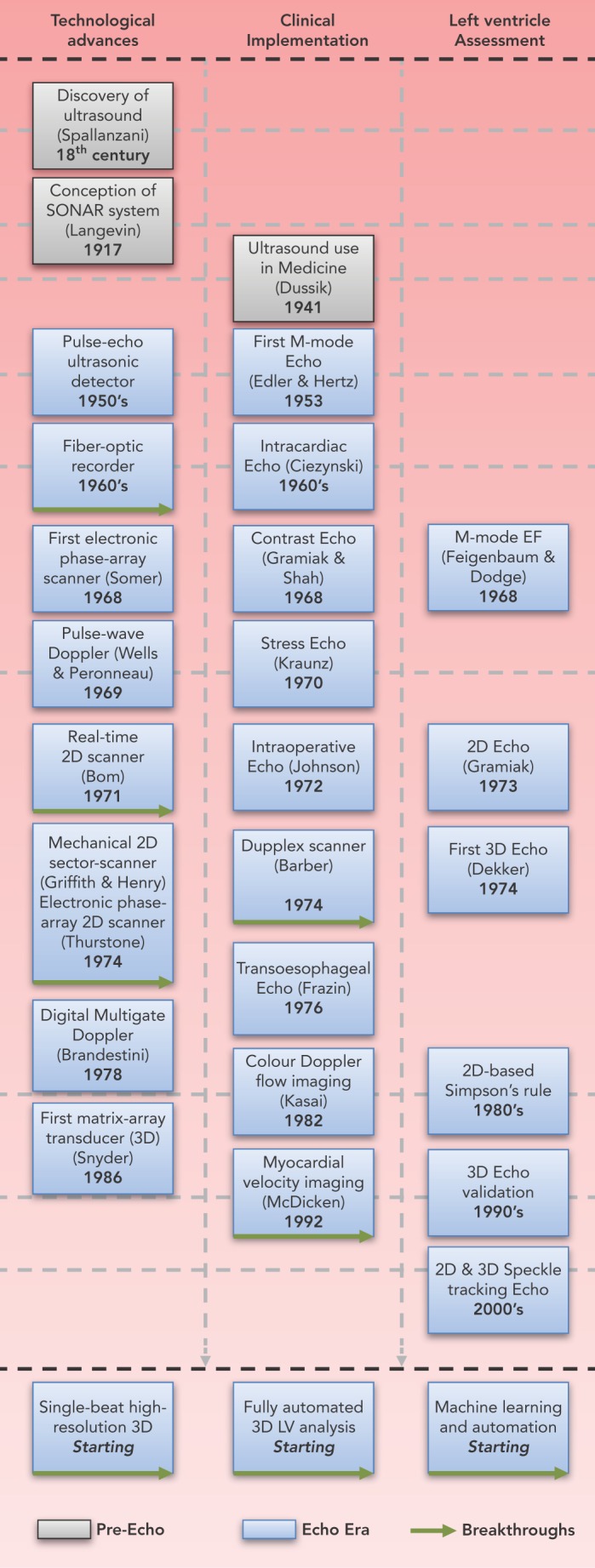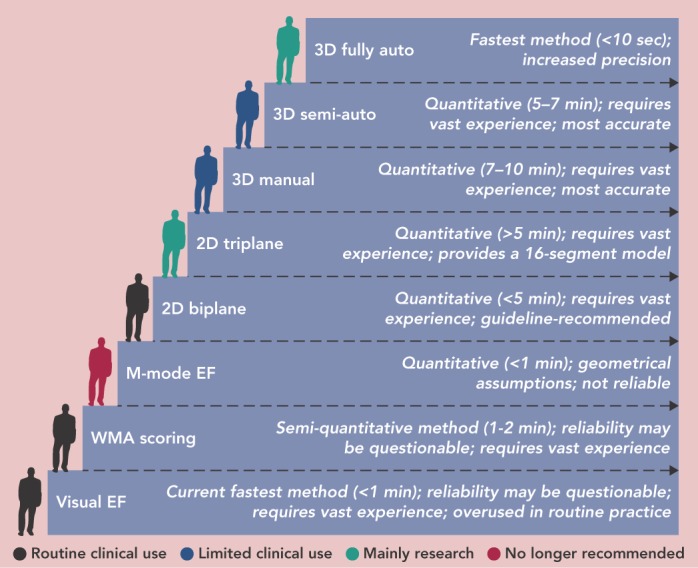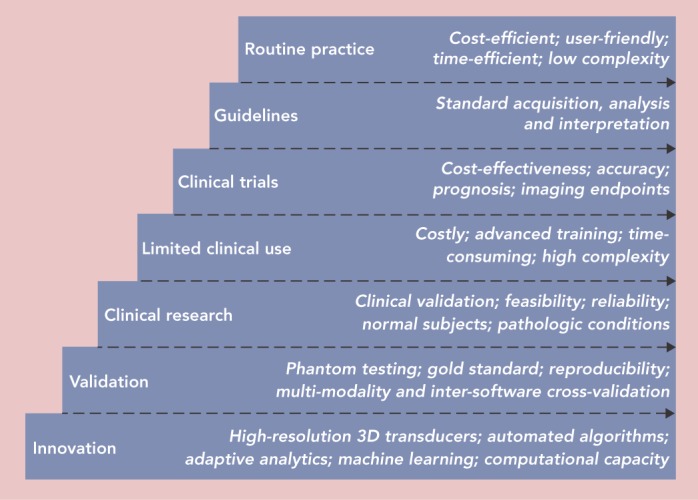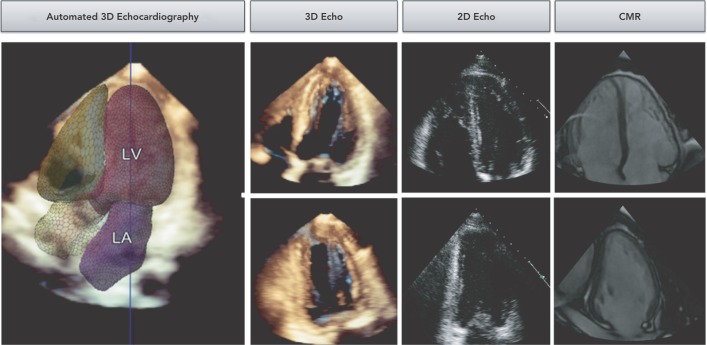Abstract
Ejection fraction is one of the most powerful determinants of prognosis and is a crucial parameter for the determination of cardiovascular therapies in conditions such as heart failure, valvular conditions and ischaemic heart disease. Among echocardiographic methods, 3D echocardiography has been attributed as the preferred one for its assessment, given an increased accuracy and reproducibility. Full-volume multi-beat acquisitions are prone to stitching artefacts due to arrhythmias and require prolonged breath holds. Single-beat acquisitions exhibit a lower temporal resolution, but address the limitations of multi-beat acquisitions. If not fully automated, 3D echocardiography remains time-consuming and resource-intensive, with suboptimal observer variability, preventing its implementation in routine practice. Further developments in hardware and software, including fully automated knowledge-based algorithms for left ventricular quantification, may bring 3D echocardiography to a definite turning point.
Keywords: 3D echocardiography, non-invasive imaging, left ventricular ejection fraction, single-beat acquisitions, automated analysis, adaptive analytics
Left ventricular ejection fraction (LVEF) is the most widely used parameter of left ventricular (LV) systolic function, and its deterioration is associated with reduced survival rates.[1] LVEF is expressed as a percent value, and calculated by dividing the stroke volume (enddiastolic volume minus end-systolic volume) by the end-diastolic volume and multiplying by 100; however, volume measurements entail a much higher complexity.[2] Despite these limitations, noninvasive imaging has become the mainstay for the assessment of LV volumes and ejection fraction (EF), and echocardiography (echo) is the workhorse modality in routine clinical practice.[3]
Echo itself provides different methods to assess LV volumes and these have evolved historically (see Figure 1). The first non-invasive assessment of EF was performed using mono-dimensional (M-mode) echocardiographic images of the heart in the late 1960s,[4] which within a lustrum transitioned to real-time 2D and 2D-derived 3D echocardiographic assessments.[5] Accuracy (closer to the gold standard) and precision (better reproducibility) – unequivocal determinants of clinical utility of echo – also progressed; yet, the position of echo as potentially the best solution for EF assessment was envisioned with the introduction of the matrix-array transducer in the late 1980s together with the progressive validation of real-time 3D echo.[6]
Figure 1: Historical Perspective of Ejection Fraction Assessment with Echocardiography.

LV = left ventricular; EF = ejection fraction; Echo = echocardiography.
Other imaging modalities for assessment of EF exist and may be preferred under specific scenarios, but are associated with an increased cost and complexity (cardiac magnetic resonance; CMR), radiation (CT) or both (nuclear imaging).[7] Notwithstanding, among all imaging modalities, CMR is generally referred to as the gold standard for the assessment of LV volumes. Image quality obtained with CMR is superior to echo despite its technically lower spatial and temporal resolution, since it is much less limited by the acoustic window (see Figure 2).[8,9] The use of short-axis slices for contouring and the possibility of long-axis corrections for the basal and apical limits of the LV may also contribute to this attribute.[10,11]
Figure 2: Image Quality Obtained with Routing Echocardiography and Cardiac Magnetic Resonance.
Among modalities, CMR offers the best differentiation between compacted myocardium and the LV cavity as it is much less limited by the acoustic window. CMR = cardiac magnetic resonance; echo = echocardiography; LA = left atrium; LV = left ventricular.
Different echo methods for the assessment of EF have been compared with CMR and currently there is no doubt that 3D echo, with good image quality, offers the closest approximation to CMR-derived volumes.[12] M-mode has been retracted as a valid method for volume derivations and 2D-derived biplane or triplane volumes may be limited by potential foreshortening and out-of-plane wall motion abnormalities.[2]
Current Status of 3D Echocardiography
Comparisons with Cardiac Magnetic Resonance
When comparing with CMR, 3D echo shows closer agreement for LV volumes quantification than 2D echo. In a meta-analysis including 28 studies comparing 3D echo with CMR in 1,198 individuals, 3D echo underestimated the LV end-diastolic volume (LVEDV) by −14 ± 5 ml and the LV end-systolic volume (LVESV) by −7 ± 3 ml, while LVEF was virtually the same among both modalities.[13] 2D-derived volumes showed a larger bias, being −33 ± 10 ml for LVEDV and −16 ± 5 ml for LVESV. In practice, this entails that LVEF, but not LV volumes, can be used interchangeably among these modalities. Concordantly, current guidelines recommend the use of biplane 2D method of disks summation (biplane Simpson’s method) and, in laboratories with experience in 3D, 3D echo is recommended when image quality is adequate for analysis.[2] Interestingly, larger biases between 3D echo and CMR have been reported in women and in patients with congenital or acquired cardiac disease.[14] Limitedcomparisons have been performed in patients with ventricularaneurysms or hypertrophic cardiomyopathy, generally excludedfrom validation studies. Noteworthy, underestimation of volumes ismore pronounced in patients with depressed LVEF, since the trueboundary (i.e. endocardial border) between compacted myocardiumand the LV cavity (blood and trabeculations) is less well defined (see Figure 2).[15] This phenomenon is also common in patients with noncompactedcardiomyopathy, and accentuated when image qualityis suboptimal.
Challenges of 3D Echocardiography
Despite the initial enthusiasm, 3D echo has not been able toreplace 2D echo in routine clinical use, and has never beensuccessfully applied in clinical trials.[16–18] Favourable characteristicsare its potentially high accuracy and precision, but these arecounterbalanced by several factors. Firstly, quality of the 3Ddatasets is determined by patient factors (e.g. acoustic window,regular cardiac rhythm and adequate breath hold), and suffers fromrelatively low temporal and spatial resolutions. Temporal resolution(i.e. volume rate) refers to the ability of localising an anatomicstructure in a point in time and is limited by the speed of sound, butcan be improved by reducing the sector size (width and depth). Inaddition, spatial resolution – defined as the ability to differentiatetwo points in space – is dependent on the number of scan linesper volume (scan line density). However, the more scan lines, thelonger the acquisition time, the lower the volume rate. Thus, smallerscanned sectors offer a better overall resolution.[16] Secondly, 3D echorequires even more in-depth knowledge of the echo settings duringacquisition in order to obtain the best image possible, as has beenrecently outlined by the European Associations of Echocardiographyand the American Society of Echocardiography.[16] Moreover, as with2D images, the analysis of 3D images has an inherent learning curvebefore obtaining reliable results.[17] Thirdly, if not fully automated,3D echo for the assessment of LVEF is still a time-consumingprocess, representing a logistical and economic challenge for theclinical work flow.
Single-beat 3D Echocardiography
Full-volume multi-beat acquisitions offer the best available 3D resolutionand provide the recommended datasets for the assessment of LVvolumes.[16] Wide-angle single-beat acquisitions, however, overcomestitching artefacts common in irregular cardiac rhythms, and avoidthe need for prolonged breath holds.[19] Initial experience with singlebeatanalysis showed similar findings to those described for manual3D when compared with CMR in patients with sinus rhythm, with abias of -18 ± 27 ml for LVEDV, -10 ± 18 ml for LVESV, and -0 ± 3 % for LVEF.[15] Furthermore, results in patients with AF were comparable withthose obtained with the biplane Simpson’s method.[15] Notwithstanding,there is a trade-off between temporal and spatial resolutions whenconsidering single-beat 3D.[19] Whereas optimally recorded multi-beatacquisitions show a temporal resolution of 33 ± 8 volumes per second(vps), superior to CMR (24 heart phases per cardiac cycle), singlebeatacquisitions may be as low as 7 ± 2 vps, which are insufficientto capture the LVESV.[12,20] In addition, the imaging modes duringacquisition influence the spatial and temporal resolutions, where theharmonic and space modes provide better spatial resolution than thefundamental and time modes with varying spatial resolution from 14 ± 2 vps up to 49 ± 7 vps. Datasets with the highest temporalresolution are those with the lowest spatial resolution.[19]
3D Ejection Fraction Assessment in the Clinical Work Flow
The current status of ejection fraction assessment in echolaboratories is summarised in Figure 3. Although not endorsedby the guidelines, echo reports with visual estimates of LVEF arefrequently observed. Visual EF is a fast method and has shownadequate accuracy with expert readers.[21] Wall motion scoring anda derived LVEF has also been implemented as a semi-quantitativealternative.[22,23] Conversely, the biplane Simpson’s method is notsystematically used in a significant proportion of echo laboratories,which points towards a practical mismatch with the guidelines.[2] 3D echo is currently confined to limited clinical use and researchuse (see Figure 4). The need for advanced training, its critical dependency on image quality and its persistent complexity may continue to limit the generalizability of 3D echo.
Figure 3: Stairway of Echocardiographic Methods for the Assessment of Left Ventricular Ejection Fraction.

EF = ejection fraction; M-mode = mono-dimensional; WMA = wall motion abnormalities.
Figure 4: Stairway from Innovation to Routine Clinical Practice for 3D Echocardiography.

Conversely, a cost- and time-efficient, user-friendly approach isneeded. This may only be possible with the advent of improvedechocardiographic probes, higher computational capacity and machinelearning technologies. Effort should be focused on the developmentof more potent probes aiming mainly to improving spatial resolution,as single-beat acquisitions with 3D echo are currently close to CMRin terms of temporal resolution.[19] This, however, is a clinical demandthat has been standing for a decade.[24] With the current limitations,3D echo for assessment of LVEF can be implemented in routineclinical flow if sufficient resources are assigned,[25] including: trainingand certification of personnel performing 3D acquisitions (includinga standard protocol); a dedicated (specialised) team for off-line 3D LVEF assessment to assure reliable measurements (accurate and reproducible); and assigning the appropriate time for acquisition, analysis, pproval and interpretation of 3D EF measurements. Consequently, the establishment of training programmes to enable widespread learning of each of the steps mentioned above has the potential to extend this technique.
Table 1: Comparisons Among Fully Automated 3D Methods and Either Cardiac Magnetic Resonance or Manual Echocardiography.
| Authors | Reference | Software | n | Feasibility | LVEDV bias (ml) | LVESV bias (ml) | LVEF bias (%) |
|---|---|---|---|---|---|---|---|
| Thavendiranathan, et al., 2012[15] (I) | CMR | eSie LVATM (Siemans Healthcare) | 101 | 66 % | -18 ± 54 | -10 ± 36 | -0 ± 6 |
| Thavendiranathan, et al., 2012[15] (II)* | 2D Simpson | eSie LVA | 27 | 89 % | 2 ± 16 | 4 ± 13 | -2 ± 4 |
| Ren, et al., 2014[19] | Manual 3D | eSie LVA | 48 | 85 % | -3 ± 23 | -2 ± 14 | -0 ± 9 |
| Otani, et al., 2016[31],* | 2D Simpson | HeartModel (Philips Healthcare) | 10 | 100 % | -3 ± 26 | -1 ± 17 | -0 ± 10 |
| Tsang, et al., 2016[30] (I) | CMR | HeartModel | 69 | 94 % | 2 ± 40 | 10 ± 40 | -6 ± 16 |
| Tsang, et al., 2016[30] (II) | Manual 3D | HeartModel | 104 | 90 % | -24 ± 50 | -13 ± 58 | -2 ± 18 |
| Spitzer, et al., 2017[32] | Manual 3D | HeartModel | 72 | 93 % | -6 ± 39 | -2 ± 39 | -1 ± 15 |
| Levy, et al., 2017[33] | CMR | HeartModel | 63 | 86 % | -22 ± 34 | -13 ± 33 | -1 ± 7 |
| Medvedofsky, et al., 2017[34],† | Manual 3D | HeartModel | 180 | 100 % | -14 ± 20 | -6 ± 16 | -2 ± 7 |
| Medvedofsky, et al., 2017[34],†,‡ | Manual 3D | HeartModel | 300 | 66 % | -3 ± 22 | 1 ± 16 | 0 ± 10 |
*Atrial fibrillation; †Including patients with arrhythmias; ‡Consecutive patients. I and II describe two reference modalities used in a single report. CMR = cardiac magnetic resonance; LVA = left ventricle analysis; LVEDV = left ventricle end-diastolic volume; LVEF = left ventricle ejection fraction; LVESV = left ventricle end-systolic volume.
Importantly, in order to use 3D echo in routine clinical practice, robustnormal reference values are required. Recent guidelines on chamberquantification provide limited data on no more than 1,780 subjects,with different ethnic backgrounds.[2] These data seem insufficient toreliably provide guidance based on gender, age and ethnicity. A recentmeta-analysis including 2,806 subjects highlighted that significantheterogeneity and inconsistency exist among studies, which calls forstandardisations and a collaborative prospective collection of data.[26]
Fully Automated 3D Ejection Fraction Assessment
Fully automated 3D EF analysis refers to obtaining quantitative resultswithout any user interaction (e.g. views selection, markers positioningand contours drawing or modification). Several scientific groups aswell as vendors have developed algorithms for 3D endocardial borderdetection.[27,28] However, most of them remain semi-automatic where theuser input is initially needed to manually annotate important landmarks (e.g. mitral plane, apex), including TomTec 4D LV-Analysis© software (TomTec Imaging Systems), Philips QLab 3DQ-Advanced software (Philips Healthcare) and GE 4D LVQ tool in the EchoPAC software (GEVingmed Ultrasound). Notwithstanding, multiple investigations onthese semi-automated methods have reported promising accuracyand reproducibility results, as well as reduced analysis time whencompared with manual 3D echo.[27]
Published data in which commercially-available software were usedin a fully automated manner is limited to two vendors, in which knowledge-based probabilistic contouring algorithms[29] or adaptiveanalytics algorithms are used.[30] Initially, it was Siemens ultrasoundthat integrated the left ventricle analysis (LVA) tool in the ACUSONSC2000 PRIME (Siemens Healthcare) workplace, which uses an expertknowledge database for border detection. Subsequently, PhilipsHealthcare incorporated the HeartModel algorithm in the Philips EPIQ7 machine. The algorithms start by automatically detecting the enddiastolicand end-systolic phases, generating preliminary endocardialsurfaces that are then compared with an existing database of 3Ddatasets. Then, the software matches volumes and shapes andgenerates a model adapted to the patients’ LV.[30] Table 1 summarises the available data on comparisons between fully automated 3Dalgorithms and either CMR or manual echo (2D or 3D).[15,17,19,30–34]
Except for one,[17] all studies investigated selected cohorts. Feasibility remains low (one-third not feasible) due to contouring algorithm failures in presence of suboptimal image quality or false data acquisition triggering.[15,17,19] However, AF does not preclude the use of fully automated algorithms, as has been demonstrated in limited number of studies.[15,31] The ease of use and the high reproducibility ofthese algorithms make this strategy a candidate for bringing 3D EF intoa widespread clinical use; however, there remain some challenges.Firstly, image quality plays a pivotal role, and results obtained withpoor but analysable image quality (evidenced in up to one-fourthof an unselected population) provide inaccurate results.[17] Secondly,existing databases of 3D datasets within the algorithms seem not toproperly address subjects with large aneurysms, complex congenitalheart disease or even dilated ventricles, where larger underestimationof volumes has been reported.[15,30] A reasonable approach would beto extend such database to specific conditions that can be selectedduring acquisition (i.e. an adaptive acquisition protocol). Thirdly,under an expert eye 80 % of fully automated contours would stillneed some degree of correction.[17] These include small changes that marginally affect the volumes and EF but also larger changes that could significantly affect the decision-making process for a specific patient. Thus, until results in larger cohorts show differently, proper training in LVEF assessment and supervision of automated contoursis strongly encouraged. Finally, both fully automated algorithms are vendor-dependent, and this technology cannot be applied to acquisitions performed with other machines. Further development and validation of a vendor-independent software, such as the TomTec 4D LV-Analysis software, may further expand the use of fully automated analysis.[35]
Conclusion
Within half a century echo has matured into the preferred non-invasive modality for the assessment of LVEF and volumes. 3D echo offers the best accuracy and reproducibility within echo cardiographic methods; however, it is still time-consuming and requires significant expertise.The advent of fully automated 3D analysis software may represent an opportunity to further promote and investigative the widespread use of 3D echo.
References
- 1.White HD, Norris RM, Brown MA et al. Left ventricular endsystolic volume as the major determinant of survival after recovery from myocardial infarction. Circulation. 1987;76:44–51. doi: 10.1161/01.CIR.76.1.44. [DOI] [PubMed] [Google Scholar]
- 2.Lang RM, Badano LP, Mor-Avi V et al. Recommendations for cardiac chamber quantification by echocardiography in adults: an update from the American Society of Echocardiography and the European Association of Cardiovascular Imaging. Eur Heart J Cardiovasc Imaging. 2015;16:233–70. doi: 10.1093/ehjci/jev014. [DOI] [PubMed] [Google Scholar]
- 3.Picard MH, Popp RL, Weyman AE. Assessment of left ventricular function by echocardiography: a technique in evolution. J Am Soc Echocardiogr. 2008;21:14–21. doi: 10.1016/j.echo.2007.11.007. [DOI] [PubMed] [Google Scholar]
- 4.Edler I, Lindström K. The history of echocardiography. Ultrasound Med Biol. 2004;30:1565–644. doi: 10.1016/S0301-5629(99)00056-3. [DOI] [PubMed] [Google Scholar]
- 5.Gowda RM, Khan IA, Vasavada BC et al. History of the evolution of echocardiography. Int J Cardiol. 2004;97:1–6. doi: 10.1016/j.ijcard.2003.07.018. [DOI] [PubMed] [Google Scholar]
- 6.Krenning BJ, Voormolen MM, Roelandt JR. Assessment of left ventricular function by three-dimensional echocardiography. Cardiovasc Ultrasound. 2003;1:12. doi: 10.1186/1476-7120-1-12. [DOI] [PMC free article] [PubMed] [Google Scholar]
- 7.Asferg C, Usinger L, Kristensen TS, Abdulla J. Accuracy of multi-slice computed tomography for measurement of left ventricular ejection fraction compared with cardiac magnetic resonance imaging and two-dimensional transthoracic echocardiography: a systematic review and meta-analysis. Eur J Radiol. 2012;81:e757–62. doi: 10.1016/j.ejrad.2012.02.002. [DOI] [PubMed] [Google Scholar]
- 8.Dorosz JL, Lezotte DC, Weitzenkamp DA et al. Performance of 3-dimensional echocardiography in measuring left ventricular volumes and ejection fraction: a systematic review and metaanalysis. J Am Coll Cardiol. 2012;59:1799–808. doi: 10.1016/j.jacc.2012.01.037. [DOI] [PMC free article] [PubMed] [Google Scholar]
- 9.Alkema M, Spitzer E, Soliman OI, Loewe C. Multimodality imaging for left ventricular hypertrophy severity grading: a methodological review. J Cardiovasc Ultrasound. 2016;24:257–67. doi: 10.4250/jcu.2016.24.4.257. [DOI] [PMC free article] [PubMed] [Google Scholar]
- 10.Wood PW, Gibson PH, Becher H. Three-dimensional echocardiography in a dynamic heart phantom: comparison of five different methods to measure chamber volume using a commercially available software. Echo Res Pract. 2014;1:51–60. doi: 10.1530/ERP-14-0051. [DOI] [PMC free article] [PubMed] [Google Scholar]
- 11.Kirschbaum SW, Baks T, Gronenschild EH et al. Addition of the long-axis information to short-axis contours reduces interstudy variability of left-ventricular analysis in cardiac magnetic resonance studies. Invest Radiol. 2008;43:1–6. doi: 10.1097/RLI.0b013e318154b1dc. [DOI] [PubMed] [Google Scholar]
- 12.Soliman OI, Kirschbaum SW, van Dalen BM et al. Accuracy and reproducibility of quantitation of left ventricular function by real-time three-dimensional echocardiography versus cardiac magnetic resonance. Am J Cardiol. 2008;102:778–83. doi: 10.1016/j.amjcard.2008.04.062. [DOI] [PubMed] [Google Scholar]
- 13.Rigolli M, Anandabaskaran S, Christiansen JP, Whalley GA. Bias associated with left ventricular quantification by multimodality imaging: a systematic review and meta-analysis metaanalysis. Open Heart. 2016;3:e000388. doi: 10.1136/openhrt-2015-000388. [DOI] [PMC free article] [PubMed] [Google Scholar]
- 14.Shimada YJ, Shiota T. A meta-analysis and investigation for the source of bias of left ventricular volumes and function by three-dimensional echocardiography in comparison with magnetic resonance imaging. Am J Cardiol. 2011;107:126–38. doi: 10.1016/j.amjcard.2010.08.058. [DOI] [PubMed] [Google Scholar]
- 15.Thavendiranathan P, Liu S, Verhaert D et al. Feasibility, accuracy, and reproducibility of real-time full-volume 3D transthoracic echocardiography to measure LV volumes and systolic function: a fully automated endocardial contouring algorithm in sinus rhythm and atrial fibrillation. JACC Cardiovasc Imaging. 2012;5:239–51. doi: 10.1016/j.jcmg.2011.12.012. [DOI] [PubMed] [Google Scholar]
- 16.Lang RM, Badano LP, Tsang W et al. EAE/ASE recommendations for image acquisition and display using three-dimensional echocardiography. Eur Heart J Cardiovasc Imaging. 2012;13:1–46. doi: 10.1093/ehjci/jer316. [DOI] [PubMed] [Google Scholar]
- 17.Medvedofsky D, Mor-Avi V, Byku I et al. Three-dimensional echocardiographic automated quantification of left heart chamber volumes using an adaptive analytics algorithm: feasibility and impact of image quality in nonselected patients. J Am Soc Echocardiogr. 2017;30:879–85. doi: 10.1016/j.echo.2017.05.018. [DOI] [PMC free article] [PubMed] [Google Scholar]
- 18.Yu CM, Abraham WT, Bax J et al. Predictors of response to cardiac resynchronization therapy (PROSPECT) study design. Am Heart J. 2005;149:600–5. doi: 10.1016/j.ahj.2004.12.013. [DOI] [PubMed] [Google Scholar]
- 19.Ren B, Vletter WB, McGhie J et al. Single-beat real-time threedimensional echocardiographic automated contour detection for quantification of left ventricular volumes and systolic function. Int J Cardiovasc Imaging. 2014;30:287–94. doi: 10.1007/s10554-013-0327-2. [DOI] [PubMed] [Google Scholar]
- 20.Macron L, Lim P, Bensaid A et al. Single-beat versus multibeat real-time 3D echocardiography for assessing left ventricular volumes and ejection fraction: a comparison study with cardiac magnetic resonance. Circ Cardiovasc Imaging. 2010;3:450–5. doi: 10.1161/CIRCIMAGING.109.925966. [DOI] [PubMed] [Google Scholar]
- 21.Thavendiranathan P, Popovic ZB, Flamm SD et al. Improved interobserver variability and accuracy of echocardiographic visual left ventricular ejection fraction assessment through a self-directed learning program using cardiac magnetic resonance images. J Am Soc Echocardiogr. 2013;26:1267–73. doi: 10.1016/j.echo.2013.07.017. [DOI] [PubMed] [Google Scholar]
- 22.Lavine SJ, Salacata A. Visual quantitative estimation: semiquantitative wall motion scoring and determination of ejection fraction. Echocardiography. 2003;20:401–10. doi: 10.1046/j.1540-8175.2003.03079.x. [DOI] [PubMed] [Google Scholar]
- 23.Galema TW, van de Ven AR, Soliman OI et al. Contrast echocardiography improves interobserver agreement for wall motion score index and correlation with ejection fraction. Echocardiography. 2011;28:575–81. doi: 10.1111/j.1540-8175.2010.01379.x. [DOI] [PubMed] [Google Scholar]
- 24.van der Heide JA, Kleijn SA, Aly MF et al. Three-dimensional echocardiography for left ventricular quantification: fundamental validation and clinical applications. Neth Heart J. 2011;19:423–31. doi: 10.1007/s12471-011-0160-y. [DOI] [PMC free article] [PubMed] [Google Scholar]
- 25.van Dalen BM, van Miltenburg AJ, Zuetenhorst HJ, Dragoiescu C. Implementation of left ventricularejection fraction assessment by three-dimensional echocardiography in daily clinical practice. J Am Soc Echocardiogr. 2017;30:932. doi: 10.1016/j.echo.2017.05.011. [DOI] [PubMed] [Google Scholar]
- 26.Buccheri S, Costanzo L, Tamburino C, Monte I. Reference values for real time three-dimensional echocardiographyderived left ventricular volumes and ejection fraction: review and meta-analysis of currently available studies. Echocardiography. 2015;32:1841–50. doi: 10.1111/echo.12972. [DOI] [PubMed] [Google Scholar]
- 27.Leung KY, Bosch JG. Automated border detection in threedimensional echocardiography: principles and promises. Eur J Echocardiogr. 2010;11:97–108. doi: 10.1093/ejechocard/jeq005. [DOI] [PubMed] [Google Scholar]
- 28.Bernard O, Bosch JG, Heyde B et al. Standardized evaluation system for left ventricular segmentation algorithms in 3D echocardiography. IEEE Trans Med Imaging. 2016;35:967–77. doi: 10.1109/TMI.2015.2503890. [DOI] [PubMed] [Google Scholar]
- 29.Yang L, Georgescu B, Zheng Y et al. A fast and accurate tracking algorithm of left ventricles in 3D echocardiography. Proc IEEE Int Symp Biomed Imaging. 2008;5:221–4. doi: 10.1109/ISBI.2008.4540972. [DOI] [PMC free article] [PubMed] [Google Scholar]
- 30.Tsang W, Salgo IS, Medvedofsky D et al. Transthoracic 3D echocardiographic left heart chamber quantification using an automated adaptive analytics algorithm. JACC Cardiovasc Imaging. 2016;9:769–82. doi: 10.1016/j.jcmg.2015.12.020. [DOI] [PubMed] [Google Scholar]
- 31.Otani K, Nakazono A, Salgo IS et al. Three-dimensional echocardiographic assessment of left heart chamber size and function with fully automated quantification software in patients with atrial fibrillation. J Am Soc Echocardiogr. 2016;29:955–65. doi: 10.1016/j.echo.2016.06.010. [DOI] [PubMed] [Google Scholar]
- 32.Spitzer E, Ren B, Soliman OI et al. Accuracy of an automated transthoracic echocardiographic tool for 3D assessment of left heart chamber volumes. Echocardiography. 2017;34:199–209. doi: 10.1111/echo.13436. [DOI] [PubMed] [Google Scholar]
- 33.Levy F, Dan Schouver E, Iacuzio L Performance of new automated transthoracic three-dimensional echocardiographic software for left ventricular volumes and function assessment in routine clinical practice: Comparison with 3 Tesla cardiac magnetic resonance. Arch Cardiovasc Dis. 2017. epub ahead of press. [DOI] [PubMed]
- 34.Medvedofsky D, Mor-Avi V, Amzulescu M Threedimensional echocardiographic quantification of the left-heart chambers using an automated adaptive analytics algorithm: multicentre validation study. Eur Heart J Cardiovasc Imaging. 2017. epub ahead of press. [DOI] [PubMed]
- 35.Eskofier J, Wefstaedt P, Beyerbach M et al. Quantification of left ventricular volumes and function in anesthetized beagles using real-time three-dimensional echocardiography: 4D-TomTec™ analysis versus 4D-AutLVQ™ analysis in comparison with cardiac magnetic resonance imaging. BMC Vet Res. 2015;11:260. doi: 10.1186/s12917-015-0568-5. [DOI] [PMC free article] [PubMed] [Google Scholar]



